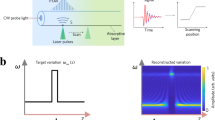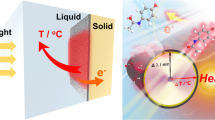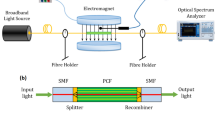Abstract
Most sensors rely on a change in an electrical parameter to the measurand of interest. Their direct readout via an electrical wire and an electronic circuit is, in principle, technically simple, but it is subject to electromagnetic interference, preventing its application in several industrial environments. Fibre-optic sensors can overcome these limitations because the sensing region and readout region can be spaced apart, sometimes by kilometres. However, fibre-optic sensing typically requires complex interrogation equipment due to the extremely high wavelength accuracy that is required. Here we combine the sensitivity and flexibility of electronic sensors with the advantages of optical readout, by demonstrating a hybrid electronic–photonic sensor integrated on the tip of a fibre. The sensor is based on an electro-optical nanophotonic structure that uses the strong co-localization of static and electromagnetic fields to simultaneously achieve a voltage-to-wavelength transduction and a modulation of reflectance. We demonstrate the possibility of reading the current–voltage characteristics of the electro-optic diode through the fibre and therefore its changes due to the environment. As a proof of concept, we show the application of this method to cryogenic temperature sensing. This approach allows fibre-optic sensing to take advantage of the vast toolbox of electrical sensing modalities for many different measurands.
This is a preview of subscription content, access via your institution
Access options
Access Nature and 54 other Nature Portfolio journals
Get Nature+, our best-value online-access subscription
$29.99 / 30 days
cancel any time
Subscribe to this journal
Receive 12 print issues and online access
$259.00 per year
only $21.58 per issue
Buy this article
- Purchase on Springer Link
- Instant access to full article PDF
Prices may be subject to local taxes which are calculated during checkout



Similar content being viewed by others
Data availability
The data that support the findings of this study are available from the corresponding author upon reasonable request. Source data are provided with this paper.
References
Bogue, R. Towards the trillion sensors market. Sensor Rev. 34, 137–142 (2014).
Alam, M., Tehranipoor, M. M. & Guin, U. TSensors vision, infrastructure and security challenges in trillion sensor era. J. Hardw. Syst. Secur. 1, 311–327 (2017).
Culshaw, B. Optical fiber sensor technologies: opportunities and—perhaps—pitfalls. J. Light. Technol. 22, 39–50 (2004).
Komma, J., Schwarz, C., Hofmann, G., Heinert, D. & Nawrodt, R. Thermo-optic coefficient of silicon at 1550 nm and cryogenic temperatures. Appl. Phys. Lett. 101, 041905 (2012).
Courts, S. S. & Swinehart, P. R. Review of CernoxTM (zirconium oxy-nitride) thin-film resistance temperature sensors. AIP Conf. Proc. 684, 393–398 (2003).
Reverter, F. A tutorial on thermal sensors in the 200th anniversary of the Seebeck effect. IEEE Sens. J. 21, 22122–22132 (2021).
Matsuura, M. Recent advancement in power-over-fiber technologies. Photonics 8, 335 (2021).
Youssefi, A. et al. A cryogenic electro-optic interconnect for superconducting devices. Nat. Electron. 4, 326–332 (2021).
Loader, B., Alexander, M. & Osawa, R. Development of optical electric field sensors for EMC measurement. In 2014 International Symposium on Electromagnetic Compatibility, Tokyo 658–661 (IEEE, 2014).
Calero, V. et al. An ultra wideband-high spatial resolution-compact electric field sensor based on lab-on-fiber technology. Sci. Rep. 9, 8058 (2019).
Peng, J. et al. Recent progress on electromagnetic field measurement based on optical sensors. Sensors 19, 2860 (2019).
Zhao, C., Cai, L. & Zhao, Y. An optical fiber electric field sensor based on polarization-maintaining photonic crystal fiber selectively filled with liquid crystal. Microelectron. Eng. 250, 111639 (2021).
Iannuzzi, D. et al. Monolithic fiber-top sensor for critical environments and standard applications. Appl. Phys. Lett. 88, 053501 (2006).
Park, B. et al. Double-layer silicon photonic crystal fiber-tip temperature sensors. IEEE Photon. Technol. Lett. 26, 900–903 (2014).
Vaiano, P. et al. Lab on fiber technology for biological sensing applications. Laser Photon. Rev. 10, 922–961 (2016).
Pevec, S. & Donlagić, D. Multiparameter fiber-optic sensors: a review. Opt. Eng. 58, 072009 (2019).
Picelli, L. et al. Scalable wafer-to-fiber transfer method for lab-on-fiber sensing. Appl. Phys. Lett. 117, 151101 (2020).
Suzuki, N. & Tada, K. Electrooptic properties and Raman scattering in InP. Jpn. J. Appl. Phys. 23, 291–295 (1984).
Bennett, B. R., Soref, R. A. & del Alamo, J. A. Carrier-induced change in refractive index of InP, GaAs, and InGaAsP. IEEE J. Quantum Electron. 26, 113–122 (1990).
Sze, S. M. & Ng, K. K. Physics of Semiconductor Devices (John Wiley & Sons, 2007).
Meiners, L. G. Temperature dependence of the dielectric constant of InP. J. Appl. Phys. 59, 1611–1613 (1986).
Lebedev, M. V. et al. InP(1 0 0) surface passivation with aqueous sodium sulfide solution. Appl. Surf. Sci. 533, 147484 (2020).
Jalil, J., Zhu, Y., Ekanayake, C. & Ruan, Y. Sensing of single electrons using micro and nano technologies: a review. Nanotechnology 28, 142002 (2017).
Shwarts, Y. M. et al. Silicon diode temperature sensor without a kink of the response curve in cryogenic temperature region. Sens. Actuator. A Phys. 76, 107–111 (1999).
Courts, S. One year stability of CernoxTM and DT-670-SD silicon diode cryogenic temperature sensors operated at 77 K. Cryogenics 107, 103050 (2020).
Cohen, B. G., Snow, W. B. & Tretola, A. R. GaAs p-n junction diodes for wide range thermometry. Rev. Sci. Instrum. 34, 1091–1093 (1963).
de Miguel-Soto, V. et al. Study of optical fiber sensors for cryogenic temperature measurements. Sensors 17, 2773 (2017).
Smartec. Cryogenic Sensing—Application Note https://smartec.ch/wp-content/uploads/2017/12/E-APN_CRYO_01-SMARTECV2.pdf (2017).
McCammon, D. Semiconductor thermistors. In Cryogenic Particle Detection (ed. Enss, C.) 35–62 (Springer, 2005).
Qiu, W., Ndao, A., Lu, H., Bernal, M.-P. & Baida, F. I. Guided resonances on lithium niobate for extremely small electric field detection investigated by accurate sensitivity analysis. Opt. Express 24, 20196–20209 (2016).
Acknowledgements
We thank T. Huiskamp and R. Serra (Eindhoven University of Technology) for help in the realization of electric-field measurement setup (Supplementary information). This work was funded by the Netherlands Organisation for Scientific Research (NWO) Zwaartekracht Research Center for Integrated Nanophotonics grant no. 024.002.033 (L.P. and P.J.v.V.). It is part of the research program of the NWO.
Author information
Authors and Affiliations
Contributions
L.P. designed, fabricated and assembled the devices and performed the experiments. P.J.v.V. performed the growth of the material layer stack. A.F. and E.V. supervised the project. L.P. and A.F. wrote the paper.
Corresponding author
Ethics declarations
Competing interests
The authors declare no competing interests.
Peer review
Peer review information
Nature Nanotechnology thanks Thomas Krauss and Avi Zadok for their contribution to the peer review of this work.
Additional information
Publisher’s note Springer Nature remains neutral with regard to jurisdictional claims in published maps and institutional affiliations.
Supplementary information
Supplementary Information
Supplementary Figs. 1–3 and discussion.
Supplementary Data 1
Source data for Supplementary Fig. 3b.
Source data
Source Data Fig. 1
Source data of the plots.
Source Data Fig. 2
Source data of the plots.
Source Data Fig. 3
Source data of the plots.
Rights and permissions
Springer Nature or its licensor (e.g. a society or other partner) holds exclusive rights to this article under a publishing agreement with the author(s) or other rightsholder(s); author self-archiving of the accepted manuscript version of this article is solely governed by the terms of such publishing agreement and applicable law.
About this article
Cite this article
Picelli, L., van Veldhoven, P.J., Verhagen, E. et al. Hybrid electronic–photonic sensors on a fibre tip. Nat. Nanotechnol. 18, 1162–1167 (2023). https://doi.org/10.1038/s41565-023-01435-x
Received:
Accepted:
Published:
Issue Date:
DOI: https://doi.org/10.1038/s41565-023-01435-x



